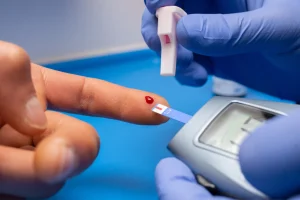If you or a loved one is managing diabetes, prediabetes, or even focusing on metabolic fitness, one question always comes up: how should I track my blood sugar?
For decades, the answer was simple: the glucometer, a small blood glucose monitor that uses a finger prick. But in recent years, a new option has entered the market – the CGM (continuous glucose monitor), often called a sugar monitoring patch.
When comparing CGM vs glucometer, both devices aim to help you manage sugar levels, but they do it in very different ways. One gives you a snapshot, while the other plays the full movie of your sugar trends. The big question is: which one is right for you?
Let’s explore the difference between a continuous glucose monitor and a blood glucose monitor, their pros and cons, and how to decide what works best for your needs.
⇒ ⇒ Read More: Sugar Test at Home with CGM: The Complete Guide to Easy & Accurate Glucose Monitoring
How Glucometers Work: The Classic Sugar Testing Machine?
A glucometer is the most common sugar testing device found in Indian households. It’s small, affordable, and widely available at pharmacies.
How It Works:
- Prick your fingertip with a lancet.
- Place a drop of blood on a test strip.
- Insert the strip into the meter.
- Get your sugar reading in seconds.
Apollo Sugar states the following advantages of Glucometers:
- Affordable: Devices start at ₹500–₹2,000. Strips cost ₹15–₹35 each.
- Quick results: Readings show up in less than 10 seconds.
- Accurate for the moment: Direct blood glucose reading, no lag.
- Portable: Pocket-sized, easy to carry.
Apollo Sugar states the following disadvantages of Glucometers:
- Finger pricks required: Every test needs one.
- Snapshot only: You know your sugar now, but not whether it’s rising or falling.
- Manual tracking: Unless app-connected, you need to log data yourself.
- Can miss patterns: Night-time spikes, post-meal highs, or hidden lows often go unnoticed.
If you’ve ever thought, “Is a glucometer reading accurate?” – yes, when used correctly. But accuracy depends on strip quality, storage, and proper technique.
User story: Meera, a 52-year-old in Delhi with Type 2 diabetes, uses her glucometer every morning before breakfast. She finds it reliable for tracking fasting sugar but admits she sometimes forgets post-meal checks, meaning she misses how her food affects her sugar levels.
⇒ ⇒ Read More: What’s The Difference Between Metabolism & Digestion?
How Continuous Glucose Monitors (CGMs) Work: The 24/7 Sugar Monitoring Patch?
A CGM is a small sensor worn on your body (usually on your arm). It measures glucose in the interstitial fluid (fluid between cells) continuously and sends data to your smartphone.
Many call it a needle-free blood sugar testing device, since daily finger pricks are avoided.
How It Works:
- Apply a small sensor patch with an applicator.
- Sensor reads sugar levels every 5–15 minutes.
- Data appears on your phone in real time.
- Receive alerts if sugar goes too high or low.
Pathcare India states the following advantages of CGMs:
- Continuous tracking: Up to 288 readings per day, even while you sleep.
- No daily pricks: Insert once every 10–14 days.
- Trend insights: Shows whether sugar is rising, falling, or stable.
- Alerts: Warns before sugar goes too high/low – lifesaving for Type 1s.
- Easy data sharing: Doctors, family, or coaches can see your readings remotely.
Pathcare India states the following disadvantages of CGMs:
- Higher cost: ₹4,000–₹5,000 per sensor in India (~₹6,000/month for continuous use).
- Slight lag: About 10–15 minutes behind actual blood sugar during fast changes.
- Regular replacement: Sensors last 7–14 days.
- Skin irritation: Some people may experience itching or rash.
CGM vs Glucometer Accuracy & Convenience

One of the biggest debates is CGM vs glucometer accuracy.
- Glucometers: Very accurate in the moment. They test capillary blood directly, so there’s no delay.
- CGMs: Highly reliable with an average MARD (Mean Absolute Relative Difference) of ~9–12%. But they measure interstitial fluid, so readings can lag slightly during rapid changes.
⇒ ⇒ Read More: Is Papaya Good for Diabetes?
Quick Comparison
| Feature | Glucometer (Fingerstick) | Continuous Glucose Monitor (CGM) |
| Accuracy | Direct blood glucose; very accurate | ~10% margin; slight lag |
| Convenience | Manual test each time | Automatic continuous data |
| Cost | ₹500 – ₹2,000 device + strips | ₹4,000 – ₹5,000 per sensor |
| Comfort | Multiple pricks daily | One patch every 10–14 days |
| Data | Snapshots only | Full trends, graphs, alerts |
So, which is more accurate: CGM or finger stick? Fingersticks are instant and precise, but CGMs give a fuller picture. Many doctors suggest using both together CGM for trends, glucometer for double-checking unusual readings.
User story: Adarsh Munjal, known as “The Big Bhookad,” used a CGM after learning he was prediabetic. He discovered which foods spiked his sugar and adjusted his diet. For him, the CGM provided insights that fingersticks never could.
⇒ ⇒ Read More: Are Bananas Good for Diabetes?
Which Device Is Right for You?
For Type 1 Diabetes
- Best option: CGM. It reduces hypoglycemia risk, provides nighttime safety, and improves HbA1c.
- Keep a glucometer as backup for double-checking.
For Type 2 Diabetes
- Best option: The Glucometer works for most, especially those on oral meds.
- CGM is useful if you’re on insulin, facing sugar fluctuations, or struggling to reach goals.
For Prediabetes
- Best option: Glucometer for fasting and post-meal checks.
- CGM can be used short-term to learn food triggers and motivate lifestyle changes.
- If you’ve ever wondered “when to check blood sugar for prediabetes,” the answer is: first thing in the morning and 1–2 hours after meals.
For Fitness & Metabolic Health Enthusiasts
- Best option: CGM (sugar monitoring patch).
- Many non-diabetics use CGMs through programs like Ultrahuman or HealthifyPro to track diet, workouts, and recovery.
User story: Harsh Kedia, “The Diabetic Chef,” wore a CGM and was surprised to find that poor sleep spiked his sugars more than eating rice. For him, CGM was a tool to “hack” his health beyond diet.
⇒ ⇒ Read More: What is a Diabetes Chart?
Glucometer vs CGM: Advantages and Disadvantages Recap
Glucometer Advantages
- Affordable, portable, easy to use
- Accurate snapshot readings
- Widely available across India
Glucometer Disadvantages
- Painful finger pricks
- Limited data (no trends)
- Misses hidden spikes/lows
CGM Advantages
- 24/7 monitoring
- Alerts for highs/lows
- Detailed trend insights
- Minimal finger pricks
CGM Disadvantages
- Expensive in India
- Slight reading lag
- Requires sensor changes
- Possible skin irritation
Summary: Making the Right Choice
Both glucometers and CGMs empower you to take control of your health.
- If cost and simplicity matter most → glucometer is your best friend.
- If continuous insights, safety, and lifestyle tracking matter → CGM is the upgrade you’ll love.
Many people use both together: a glucometer for spot checks, CGM for the bigger picture.
Ready to experience real-time sugar tracking?
Buy smart CGM to track your glucose 24/7, avoid painful pricks, and take charge of your health today.








